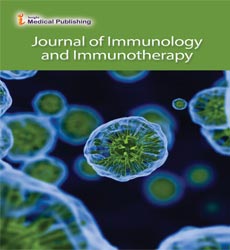Primary Antibody Deficiency (PAD)
Oliver Caruso*
Editorial office, Journal of Immunology and Immunotherapy, United Kingdom
- *Corresponding Author:
- Oliver Caruso Editorial office, Journal of Immunology and Immunotherapy, United Kingdom E-mail: jmso@emedicinejournals.org
Received Date: March 30, 2021; Accepted Date: April 02, 2021; Published Date: April 12, 2021
Citation: Caruso O (2021) Primary Antibody Deficiency (PAD).J Immuno Immunother. Vol.5 No.2:06.
Editorial Note
Primary antibody deficiencies account for 56% (ESID Registry) of all Primary Immunodeficiency (PID), but the proportion of patients with antibody deficiency as a component of their disease is even higher, at nearly 75%. While the majority of such individuals encounter recurrent infections, it has become obvious in recent years that a significant minority are also afflicted by non-infectious dysregulatory consequences such as cancer, autoimmunity, inflammation, and allergies. The immensely complex forms of Primary Antibody Deficiencies (PAD) have a significant influence on patient's treatment and present diagnostic and therapeutic challenges.
Genetics
Our understanding of the genetics of Primary Antibody Deficiency (PAD) has advanced in recent years, with the most significant partial haplotype connected with the unresolved CVID as W*01:01:01-DMA*01:01:01-DMB*01:03:01:02-TAP1*01:01:01. Aside from the large number of BTK mutations that have been described, some atypical clinical manifestations in XLA patients have been described and linked to a novel hemizygous c.1632- 1G> A mutation in the BTK gene in a child with atypical X-Linked Agammaglobulinemia and recurrent Hemophagocytosis (HLH) whose HLH remission was finally achieved after he received monthly Ig replacement.
Patient Management
As earlier noted, additional breakthroughs in understanding essential features of primary antibody deficiency-related illnesses should aid in advancements in diagnosis and management. A high prevalence of both anterior pituitary and end-organ endocrine dysfunction(secondaryhypothyroidism,secondaryhypogonadism, premature ovarian failure, primary testicular failure, partial adrenal insufficiency, severe growth or mild hormone deficiency) was identified in adult PAD, suggesting that an assessment of the endocrine axis should be considered. A thorough description of a CVID-related non-infectious consequence was provided. Two- thirds of CVID patients had autoimmunity, chronic lung disease, lymphoid hyperplasia/splenomegaly, liver disease, granulomas, gastrointestinal disease, lymphoma, and other malignancies. These problems can occur in the same patient and lead to a wide range of linked consequences. Such growth could be slowed by an active multidisciplinary approach. Even in the absence of confirmed infections, further exacerbations, such as persistent lung damage and bronchiectasis, may occur. Similarly, in the liver, granulomas and nodular regenerative hyperplasia progressing to portal hypertension did not afflict around half of CVID patients who did not have nor had monogenic types of CVID such as ICOS, NFKB1, NFKB2, CTLA-4, PI3Kδ pathway, ADA2, and IL21-R genetic abnormalities.
Pathogenesis
Hypogammaglobulinemia, a low frequency of isotype-switched memory B cells, and impaired B-cell development into memory or antibody-secreting cells are all symptoms of CVID. Further research into the cellular defects underlying CVID pathogenesis reveals that circulating IgM memory B cells play a distinct role in mucosal protection, as well as the existence of a functional gut- spleen axis in which TACI-expressing IgM memory B cells producing IgA were localized under the epithelial cell layer, where the TACI ligand APRIL was rich. The impairment of mucosal immunity might outcome in less diverse and significantly altered bacterial, but not fungal gut microbiota in CVID patients, apparently associated with a more severe disease phenotype though described as B cell intrinsic disease, numerous abnormalities have been stated in other immune cell compartments as in follicular helper T cells, a CD4+T cell population specialized in B cell help and address the aspects of immune dysregulation associated with autoimmunity, including elevations of T helper type-1 and follicular helper T cells and B cells expressing low levels of CD21 as well as a decrease in regulatory T cells.
Diagnosis
The differential diagnosis with secondary types of hypogammaglobulimia, particularly those linked with lymph proliferative disorders, is an often unsolved element in the therapy of antibody shortages. Some researchers claimed that serum free light chain analysis could help distinguish CVID from other causes of hypogammaglobulinemia and aid in the early detection of monoclonal lymph proliferation that occurs over time. Overall, CVID patients had low and chain concentrations. The most common pattern was κ-λ-, followed by κ−λ+, κ+λ+, and κ+λ-, while κ+λ+ were used in secondary forms.
Controversies
Perception of solid organ transplantation and hematopoietic stem cell transplantation in patients with primary antibody deficiency is limited, and this component of management requires further investigation, in addition to the increasing potential of gene therapy and gene editing.
Open Access Journals
- Aquaculture & Veterinary Science
- Chemistry & Chemical Sciences
- Clinical Sciences
- Engineering
- General Science
- Genetics & Molecular Biology
- Health Care & Nursing
- Immunology & Microbiology
- Materials Science
- Mathematics & Physics
- Medical Sciences
- Neurology & Psychiatry
- Oncology & Cancer Science
- Pharmaceutical Sciences
